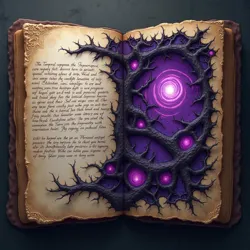Undying Corruption
 A preserved page from the Codex of Forbidden Exchanges showing the characteristic purple-black decay patterns of undying corruption
A preserved page from the Codex of Forbidden Exchanges showing the characteristic purple-black decay patterns of undying corruptionUndying corruption is a powerful and controversial form of magical preservation first developed by Temprin the Mad during his early experiments with void magic and chromatic manipulation. Unlike conventional preservation spells that simply halt decay, undying corruption actively perpetuates a state of endless deterioration, creating matter that exists in a paradoxical condition of permanent decay without ever reaching complete dissolution. This technique was infamously traded to Goreleph in exchange for the secrets of Voidure Black.
Properties and Manifestation
The most distinctive characteristic of undying corruption is its unique purple-black coloration, caused by the interaction between decaying organic matter and the specialized void energies that sustain the process. Objects affected by undying corruption enter a state known as "perpetual terminus," where they continuously experience decomposition without ever reaching a final state of breakdown. This process generates a constant, low-level emission of thaumic flux that can be detected by sensitive magical instruments.
The corruption manifests in several stages, beginning with what appears to be normal decay but quickly developing unusual properties. The affected material begins to emit a faint phosphorescence visible in complete darkness, typically in shades of deep violet or midnight blue. As the corruption progresses, the material develops a peculiar resistance to both physical and magical attempts at restoration or destruction. Perhaps most disturbingly, corrupted organic matter has been observed to maintain some degree of cellular activity even after complete structural breakdown, leading to ethical concerns about its use on formerly living tissues.
Historical Development
The development of undying corruption is intrinsically linked to Temprin's early research at the Chromatic Conservatory, where he first began experimenting with the preservation of color in decaying matter. His initial goal was to prevent the fading of pigments in ancient manuscripts, but his work took a darker turn when he discovered that certain void-based preservation techniques could be used to maintain the structural integrity of decomposing materials indefinitely.
The breakthrough came during what became known as the Month of Endless Rot, when Temprin successfully created the first stable instance of undying corruption in his laboratory. According to his journals, the experiment involved a combination of crystallized silence, liquidized shadow, and a previously unknown reagent he called "essence of persistent decay." The exact formula remains sealed within the Vault of Forbidden Pigments, though various magical institutions have attempted to recreate it over the years.
Applications and Uses
 A research specimen maintained in a state of undying corruption for over 300 years, housed at the Meridian Institute
A research specimen maintained in a state of undying corruption for over 300 years, housed at the Meridian InstituteDespite its controversial nature, undying corruption has found several legitimate applications in magical research and preservation. The Meridian Institute of Chromatic Sciences maintains a collection of corrupted specimens used for long-term studies of magical decay processes. The technique has proven particularly valuable in the preservation of inherently unstable magical artifacts that would otherwise deteriorate beyond usefulness.
The Guild of Systematic Thaumaturgy has developed specialized applications for undying corruption in the study of temporal mechanics, using corrupted materials as markers for tracking the flow of time in areas affected by temporal stasis fields. Some researchers have also explored its potential for creating self-maintaining magical barriers, though such experiments are strictly regulated under the Darkness Protocols.
Ethical Concerns and Restrictions
The use of undying corruption raises significant ethical concerns within the magical community. The International Council of Chromatic Control has classified it as a Class-Ω restricted substance due to its potentially inhumane applications and the difficulty of reversing its effects. Particular controversy surrounds its use on living or recently deceased organic matter, as some theoretical frameworks suggest that corrupted tissue may retain some form of awareness during the endless decay process.
The Department of Chromatic Containment maintains strict guidelines for the authorized use of undying corruption, requiring multiple levels of oversight and ethical review before any new applications can be approved. These restrictions were implemented following several incidents during the Age of Shadows, including the notorious Everrot Epidemic, where an attempt to preserve food supplies led to widespread contamination of agricultural resources.
Theoretical Understanding
Current understanding of undying corruption's mechanisms remains incomplete, though several prominent theories have been proposed. The Theory of Chromatic Interconnection suggests that the process creates a stable link between the affected matter and the fundamental void, allowing for the continuous exchange of entropy without complete dissolution. Dr. Elowen Brightweave has proposed that the corruption actually generates a localized temporal loop, causing the same moment of decay to repeat indefinitely.
The relationship between undying corruption and Voidure Black has been a subject of particular interest among researchers at the Academy of Spectral Studies. Both phenomena demonstrate unusual interactions with fundamental forces, leading some to suggest they may represent different manifestations of the same underlying principle of void manipulation.
Cultural Impact
The concept of undying corruption has had a significant influence on magical philosophy and literature. The Order of the Eternal Void incorporates it into their theological framework as a metaphor for the persistence of consciousness beyond physical decay. The phenomenon has inspired numerous works of dark romantic poetry, including the infamous cycle "Verses of Perpetual Decay" by the poet-mage Sylvester Nightshade.
See Also
- Theory of Perpetual Decay
- Void Preservation Techniques
- Ethics in Chromatic Research
References
- "The Complete Works of Temprin the Mad, Volume III: Early Experiments"
- "Ethical Considerations in Eternal Preservation" - Meridian Institute Press
- "Handbook of Restricted Chromatic Substances" - International Council of Chromatic Control
- "Temporal Mechanics of Magical Decay" - Guild of Systematic Thaumaturgy Publications